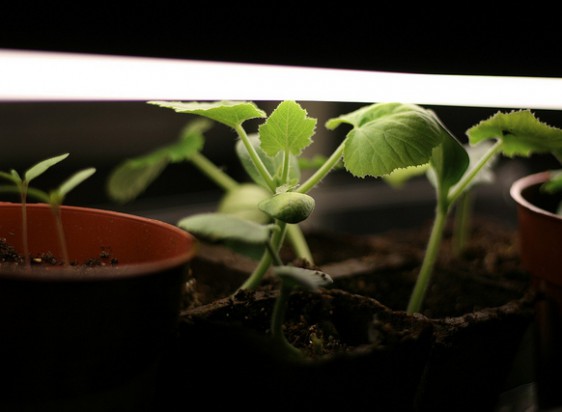Two Green Thumbs Up for Grow Bulbs
Lighting - by Jessica Carey - updated on 3/22/2013
Whether you're an extreme gardener, prefer greenhouses or are simply starting your spring garden indoors during the remaining cold months, all plants need sunlight and the best way to get it indoors is by using plant grow light bulbs.
Quick Tips
- Your light needs to have the same wavelengths as the sun, which is why a regular light bulb doesn't work.
- The light should be as close to the plant as possible without burning the leaves.
- Most vegetables and other plants do best with 14-16 hours of sunlight or simulated light.
- If your plant isn't getting enough light, it usually will have small leaves, thin stems and the color will be lighter than usual.
How Grow Lights Work
Grow lights work by simulating natural light and assuming traits similar to those that a plant outdoors would experience under ideal conditions. These lamps are designed to be used indoors and to advocate plant growth, flowering and fruiting by providing the appropriate shades of light from the electromagnetic color spectrum. Different types of lighting will emit various degrees of light and colors needed for the photosynthesis process.
Using grow lights on your indoor plants is an excellent option if you live in an area that doesn't get many hours of daylight. However, no matter where you live or what time of year it is, grow lights are great for indoor gardening. Even plants grown near a window will probably not get enough light during the winter months to thrive.
If you're thinking about adding grow lights to your indoor garden, you have to consider which bulbs to use and why.
Bulb Types
Incandescent
These lights are the most inexpensive to purchase but can only provide additional light to individual house plants – they cannot serve as the sole light source. Incandescent grow lights have a low light output per watt compared to HID and fluorescent grow lights (one 400W HID is equal to 84 60W incandescents).
HID Lights
The brightest grow lights are high-intensity discharge (HID) lights. They can be installed anywhere in your home, garage or greenhouse to supplement existing light or serve as the sole source of light for your plants.

There are two categories of HID lamps: metal halide and high-pressure sodium. Both emit a much more intense light than fluorescent bulbs. Metal halide light bulbs provide outstanding color rendering in an HID lamp. They provide white lighting that is the most similar to natural sunlight.
High-pressure sodium lamps are great for lighting a wide area. They create extremely bright light that draws mostly red and orange from the color spectrum, which means that they are best suited for promoting flowering and fruit growth.
High-Intensity Fluorescent Plant Grow Lights
High-intensity fluorescent bulbs are also an excellent choice. The fixtures resemble those of HID bulbs, but they are less expensive and available in cool & warm colors that fit in the same ballast.
Fluorescent Plant Lights
Traditional fluorescent tubes are the most economical choice if you're going to use grow lights. They can be used in inexpensive shop light fixtures or multitier growing carts. Newer types of fluorescent grow lights, such as full spectrum fluorescent light systems, are more powerful than standard fluorescent bulbs and allow for more concentrated lighting, which is helpful for growing herbs, houseplants and cacti or for providing supplemental lighting in a greenhouse.
Choose a standard fluorescent for starting your seedlings, an HO fluorescent for limited-space areas or a CFL for focused high-output growth efforts.
Heat Lamps
Heat lamps may be required if you live in a cold climate or your plants are kept in a space such as a greenhouse or a garage – you have to keep your plants toasty warm.
Choosing Wattage
Once you've decided which kind of plant grow light you want, you'll need to decide how much wattage to use for the space you have. Use our helpful guide:
| Wattage | Area Coverage Recommended | Size of Space | Mounting Height About Plants |
|---|---|---|---|
| 400 Watt | no outside light some outside light |
5x5' area 8x8' area |
1 – 4 ft |
| 600 Watt | no outside light some outside light |
7x7' area 10x10' area |
1.5 – 5 ft |
| 1000 Watt | no outside light some outside light |
8x8' area 12x12' area |
2 – 6 ft |
Get optimum growth from your flowers, plants and vegetables with premium plant lights and growth lamps. At Batteries Plus, we offer a full complement of lights, fluorescent tubes and heat lamps to provide your plants the indoor equivalent to sunlight. Shatterproof options are also available, so visit your nearest store today.
And remember, we're social, so follow us!

